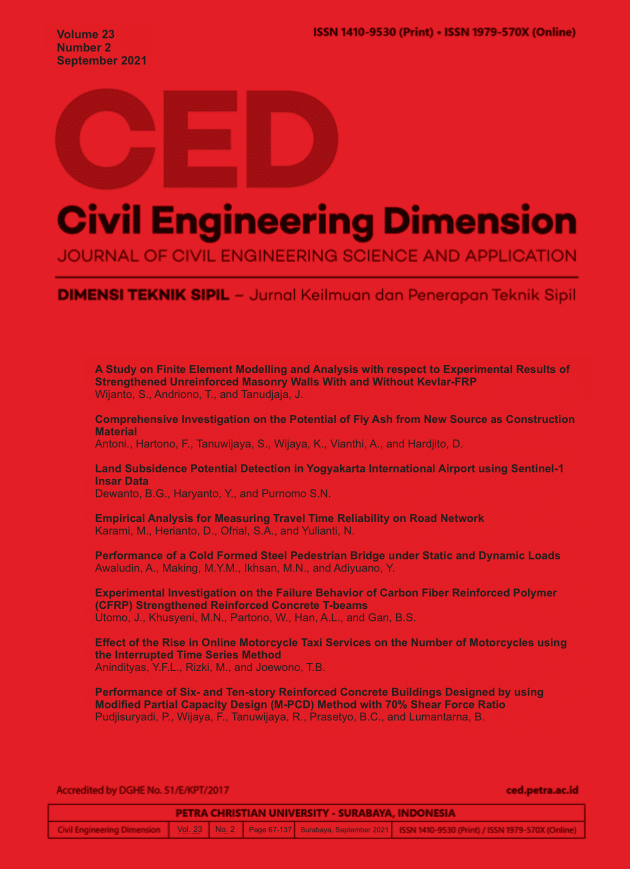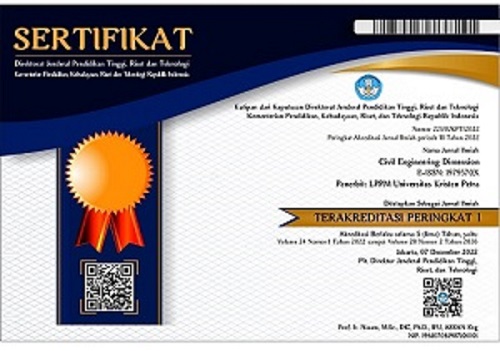Empirical Analysis for Measuring Travel Time Reliability on Road Network
 :
:
https://doi.org/10.9744/ced.23.2.100-107
Keywords:
Buffer time methods, travel time, travel time reliabilityAbstract
This research analyses the characteristics of travel time reliability for the road network in Kota Bandar Lampung. Therefore, travel time consists of access, wait and interchange time, while its reliability deals with variations of in-passenger/private cars time. Survey of travel time on each road was carried out for 12 hours (from 06.00 to 18.00) for five working days. Furthermore, the buffer time method was used to measure the characteristics of time travel reliability consisting of five measuring tools, namely planning time, planning time index, buffer time, buffer time index and travel time index. This research found that the temporal effects are the main factor that tends to affect travel time, whereas network effects are the second factor that tends to affect travel time. Furthermore, the regression equation was developed to express the effect of planning time (TPlan) and free-flow travel time on average travel time .
References
Tu, H., Monitoring Travel Time Reliability on Freeways, PhD Thesis, Department of Transport and Planning, Delft University of Technology, Delft, 2008, pp. 1-192.
Higatani, A., Kitazawa, T., Tanabe, J., Suga, Y., Sekhar, R., and Asakura, Y., Empirical Analysis of Travel Time Reliability Measures in Hanshin Expressway Network, Journal of Intelligent Transportation Systems, 13(1), 2009, pp. 28-38, https://doi.org/10.1080/15472450802644454
Chang, J.S., Assessing Travel Time Reliability in Transport Appraisal, Journal of Transport Geography, 18(3), 2010, pp. 419-425, http://dx.doi.org/ 10.1016/j.jtrangeo.2009.06.012
Lyman, K. and Bertini, R.L., Using Travel Time Reliability Measures to Improve Regional Transportation Planning and Operations, Transportation Research Record, 2046(1), 2008, pp. 1-10, https://doi.org/10.3141/2046-01
Florida Department of Transportation (FDOT), The Florida Reliability Method in Florida’s Mobility Performance Measures Program, Florida Department of Transportation Tallahassee, Florida, 2000
Federal Highway Administration, Travel Time Reliability: Making It There on Time, All the Time, https://ops.fhwa.dot.gov/publications/treliability/TTR_report.htm2020, 2020
Bremmer, D., Cotton, K.C., Cotey, D., Prestrud, C.E., and Westby, G., Measuring Congestion: Learning from Operational Data, Transportation Research Record, 1895(1), 2004, pp. 188-196, https://doi.org/10.3141/1895-24
Mahmassani, H.S., Hou, T., and Saberi, M., Connecting Networkwide Travel Time Reliability and the Network Fundamental Diagram of Traffic Flow, Transportation Research Record, 2391(1), 2013, pp. 80-91, https://doi.org/10.3141/ 2391-08
Bhouri, N., Haj-Salem, H., and Kauppila, J., Iso-lated Versus Coordinated Ramp Metering: Field Evaluation Results of Travel Time Reliability and Traffic Impact, Transportation Research Part C: Emerging Technologies, 28, 2013, pp. 155-167, https://doi.org/10.1016/j.trc.2011.11.001
Bates, J., Dix, M., and May, A.D., Travel Time Variability and Its Effect on Time of Day Choice for the Journey to Work, in 15th PTRC Summer Anual Meeting-Planning and Transport Research and Computation, London, 1987, pp. 293-311
Noland, R.B. and Polak, J.W., Travel Time Variability: a Review of Theoretical and Empirical Issues, Transport Reviews, 22(1), 2002, pp. 39-54, https://doi.org/10.1080/01441640010022456
Shao, H., Lam, W., Meng, Q., and Tam, M., A Demand Driven Travel Time Reliability-Based Traffic Assignment Problem, Transportation Research Record, 2006 pp. 220-230
Liu, H.X., Recker, W., and Chen, A., Uncovering the Contribution of Travel Time Reliability to Dynamic Route Choice using Real-Time Loop Data, Transportation Research Part A: Policy and Practice, 38(6), 2004, pp. 435-453, https://doi.org/ 10.1016/j.tra.2004.03.003
Dong, J. and Mahmassani, H.S., Flow Break¬down and Travel Time Reliability, Transportation Research Record, 2124(1), 2009, pp. 203-212, https://doi.org/10.3141/2124-20
Dong, J., Mahmassani, H.S., and Lu, C.C., How Reliable is this Route? Predictive Travel Time and Reliability for Anticipatory Traveler Information Systems, Transportation Research Record, 1980(1), 2006, pp. 117-125, https://doi. org/10. 1177/0361198106198000116
Hasan, M., Ganguly, B., Chowdhury, S.R., Rah-man, G.A., Sami, S., and Sultana, J., Analyzing the Impact of Land Use and Roadside Informal Activity on Transportation System: A Case Study in Rajshahi City Corporation, Bangladesh, Inter-national Journal of Transportation Engineering and Traffic System, 4(2), 2018, pp. 18-31
Li, Z., Hensher, D.A., and Rose, J.M., Willingness to Pay for Travel Time Reliability in Passenger Transport: A Review and Some New Empirical Evidence, Transportation Research Part E: Logistics and Transportation Review, 46(3), 2010, pp. 384-403, https://doi.org/10.1016/j.tre.2009.12.005
Cambridge Systematics Inc. and Texas Transportation Institute, Traffic Congestion and Reliability: Trends and Advanced Strategies for Congestion Mitigation, Federal Highway Admi-nistration, United States, Sept. 2005
Ando, N. and Taniguchi, E., Travel Time Relia-bility in Vehicle Routing and Scheduling with Time Windows, Networks and Spatial Econo-mics, 6, 2006, pp. 293-311, https://doi.org/10.1007/ s11067-006-9285-8
Taylor, M.A., Modelling Travel Time Reliability with the Burr Distribution, Procedia-Social and Behavioral Sciences, 54, 2012, pp. 75-83, https://doi.org/10.1016/j.sbspro.2012.09.727
Chen, C., Skabardonis, A., and Varaiya, P., Travel-Time Reliability as a Measure of Service, Transportation Research Record, 2003, 1855(1), 2003, pp. 74-79, https://doi.org/10.3141/1855-09
Downloads
Published
How to Cite
Issue
Section
License
Authors who publish with this journal agree to the following terms:- Authors retain the copyright and publishing right, and grant the journal right of first publication with the work simultaneously licensed under a Creative Commons Attribution License that allows others to share the work with an acknowledgement of the work's authorship and initial publication in this journal.
- Authors are able to enter into separate, additional contractual arrangements for the non-exclusive distribution of the journal's published version of the work (e.g., post it to an institutional repository or publish it in a book), with an acknowledgement of its initial publication in this journal.
- Authors are permitted and encouraged to post their work online (e.g., in institutional repositories or on their website) followingthe publication of the article, as it can lead to productive exchanges, as well as earlier and greater citation of published work (See The Effect of Open Access).

















